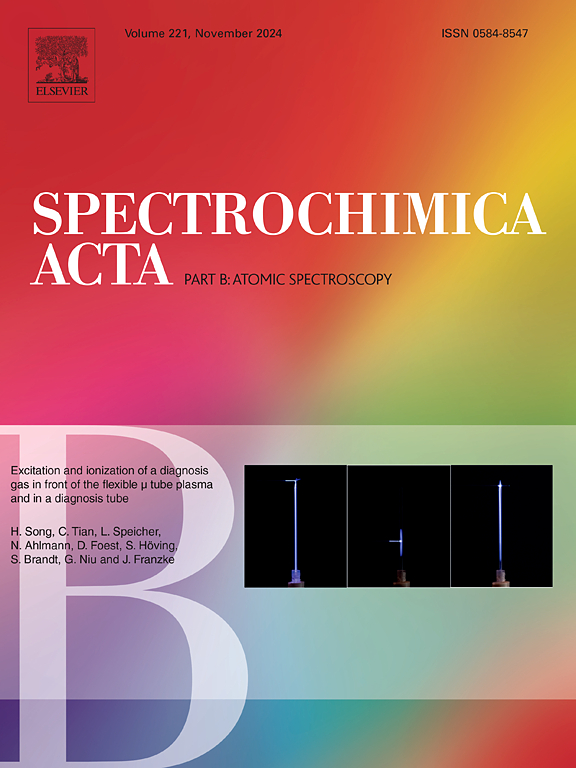Reliability of LA-ICP-MS and synchrotron XANES for provenance identification of rubies
IF 3.2
2区 化学
Q1 SPECTROSCOPY
引用次数: 0
Abstract
Modern gemological laboratories face significant challenges in determining the geographical origin of rubies, requiring careful analysis of inclusions, trace element chemistry, and spectroscopic data. In this work, trace elements of rubies from Myanmar, Madagascar and Mozambique were investigated by using the LA-ICP-MS technique. The iron concentration in the rubies from Madagascar and Mozambique are higher than 1000 μg/g while the titanium concentration is less than 5 μg/g. In the Myanmar marble-hosted ruby, the iron concentration is below 10 μg/g while titanium concentration of a few thousands' μg/g is generally detected. The X-ray absorption near edge structure (XANES) spectra were taken from the high iron containing and marble-hosted rubies for obtaining the chemical information of iron and titanium, respectively. The XANES spectra reveals that trivalent iron is the major species in rubies of high iron rubies. Similarly, Cr K-edge XANES spectra are obtained for Cr3+ in rubies from two different sources. Ti K-edge XANES spectra in ruby from Myanmar show a 4+ oxidation state, and its XANES spectrum resembles that of TiO2 with a rutile phase.

LA-ICP-MS和同步加速器XANES鉴别红宝石来源的可靠性
现代宝石学实验室在确定红宝石的地理来源方面面临着重大挑战,需要仔细分析内含物、微量元素化学和光谱数据。本文采用LA-ICP-MS技术对缅甸、马达加斯加和莫桑比克红宝石中的微量元素进行了研究。马达加斯加和莫桑比克红宝石中的铁含量均高于1000 μg/g,钛含量均低于5 μg/g。在缅甸大理岩型红宝石中,铁含量一般低于10 μg/g,钛含量一般为几千μg/g。采用x射线吸收近边结构(XANES)对高含铁红宝石和大理岩红宝石进行了光谱分析,分别获得了铁和钛的化学信息。XANES光谱分析表明,三价铁是高铁红宝石的主要成分。同样,从两个不同的来源获得了红宝石中Cr3+的Cr k边XANES光谱。缅甸红宝石中的Ti K-edge XANES光谱显示为4+氧化态,其XANES光谱与具有金红石相的TiO2相似。
本文章由计算机程序翻译,如有差异,请以英文原文为准。
求助全文
约1分钟内获得全文
求助全文
来源期刊
CiteScore
6.10
自引率
12.10%
发文量
173
审稿时长
81 days
期刊介绍:
Spectrochimica Acta Part B: Atomic Spectroscopy, is intended for the rapid publication of both original work and reviews in the following fields:
Atomic Emission (AES), Atomic Absorption (AAS) and Atomic Fluorescence (AFS) spectroscopy;
Mass Spectrometry (MS) for inorganic analysis covering Spark Source (SS-MS), Inductively Coupled Plasma (ICP-MS), Glow Discharge (GD-MS), and Secondary Ion Mass Spectrometry (SIMS).
Laser induced atomic spectroscopy for inorganic analysis, including non-linear optical laser spectroscopy, covering Laser Enhanced Ionization (LEI), Laser Induced Fluorescence (LIF), Resonance Ionization Spectroscopy (RIS) and Resonance Ionization Mass Spectrometry (RIMS); Laser Induced Breakdown Spectroscopy (LIBS); Cavity Ringdown Spectroscopy (CRDS), Laser Ablation Inductively Coupled Plasma Atomic Emission Spectroscopy (LA-ICP-AES) and Laser Ablation Inductively Coupled Plasma Mass Spectrometry (LA-ICP-MS).
X-ray spectrometry, X-ray Optics and Microanalysis, including X-ray fluorescence spectrometry (XRF) and related techniques, in particular Total-reflection X-ray Fluorescence Spectrometry (TXRF), and Synchrotron Radiation-excited Total reflection XRF (SR-TXRF).
Manuscripts dealing with (i) fundamentals, (ii) methodology development, (iii)instrumentation, and (iv) applications, can be submitted for publication.

 求助内容:
求助内容: 应助结果提醒方式:
应助结果提醒方式:


